

“As the U.S. Green Building Council celebrates 25 years of market leadership and growth, we know how important green building practices and certifications are to ensuring a more sustainable future for all,” said Mahesh Ramanujam, president and CEO, USGBC. “These states showcase exceptional leadership and by using LEED, businesses, property owners and policy makers in these states are strategically addressing some of the most critical social and environmental concerns of our time. LEED is a proven economic development tool and method of meeting carbon reduction targets, reducing waste, energy and water consumption, and more. By measuring success on a per capita level each year, this list reflects the personal and individual impact of these states’ efforts. We commend the community leaders, businesses and government bodies in all ten of these states for their ongoing efforts and dedication to a better quality of life for everyone.”
Now in its eighth year, the list is based on 2010 U.S. Census data and includes commercial and institutional green building projects that were certified throughout 2017. Massachusetts retained its top position for the second year in a row with 130 LEED certifications representing 4.48 square feet of LEED-certified space per resident, the highest since 2010.
The mid-Atlantic continues to show strong regional leadership, with both Maryland and Virginia returning to the list for the seventh year running. Also notable, Washington, D.C., which is not included in the official list of top states due to its status as a federal territory, tops the nation with 39.83 square feet of space per resident certified in 2017.
With Georgia, Hawaii and Minnesota all returning to the list for the first time since 2014, it is clear that market uptake for LEED is strong nationwide and not limited to any particular region or corridor. Illinois and Colorado are the only states to have made the list every year since the inception of the ranking in 2010. This year, Illinois comes in third with 3.38 square feet per capita and Colorado places 10th with 2.27 square feet per capita. The 2017 list has the highest average square footage per resident per state since 2010 (2.9). The full ranking is as follows:
|
2017 Top 10 States for LEED |
||||
|
Rank |
State |
Certified Gross |
GSF Per Capita |
Number of |
|
1 |
MA* |
29,338,378 |
4.48 |
130 |
|
2 |
NY* |
65,749,387 |
3.39 |
192 |
|
3 |
IL* |
43,363,065 |
3.38 |
135 |
|
4 |
HI |
4,519,757 |
3.32 |
16 |
|
5 |
MD* |
15,854,679 |
2.75 |
105 |
|
6 |
MN |
13,018,056 |
2.45 |
47 |
|
7 |
GA |
23,638,051 |
2.44 |
71 |
|
8 |
CA* |
89,258,519 |
2.4 |
475 |
|
9 |
VA* |
18,589,482 |
2.32 |
152 |
|
10 |
CO* |
11,397,964 |
2.27 |
76 |
|
** |
DC |
23,966,817 |
39.83 |
139 |
*Included in 2016 Top 10 States for LEED list
**Washington, D.C. is not ranked as it is a federal district, not a state
USGBC calculates the list using per capita figures to allow for a fair comparison of the level of green building taking place among states with significant differences in population and number of overall buildings.
In 2017, LEED for Building Operations and Maintenance (LEED O+M) was once again the most popular rating system within the Top 10 States, representing more than 50 percent of the total square footage certified. LEED for Building Design and Construction (LEED BD+C) was the second most popular and LEED for Interior Design and Construction (LEED ID+C) was the third most popular rating system.
Collectively, 1,399 commercial and institutional projects achieved LEED certification within the Top 10 States in 2017, representing 314.7 million square feet of real estate. Nationwide, 2,647 commercial and institutional projects achieved LEED certification in 2017, representing 484.6 million square feet of real estate.
More than 40,000 commercial and institutional projects representing more than 6.5 billion square feet of space have been LEED-certified to date worldwide, with another 51,000 projects representing 13 billion square feet in the pipeline for certification. LEED’s newest version, LEED v4, features increased technical rigor; new market sector adaptations for data centers, warehouses and distribution centers, hospitality, existing schools, existing retail and midrise residential projects; and a simplified submission process supported by a robust and intuitive technology platform.
Tracking ongoing building performance is a growing priority and a number of projects in the Top 10 States achieved certification through the Arc online performance platform, which uses data to measure and improve sustainability performance. Arc delivers a performance score based on building data and action-oriented strategies across energy, water, waste, transportation and human experience.
